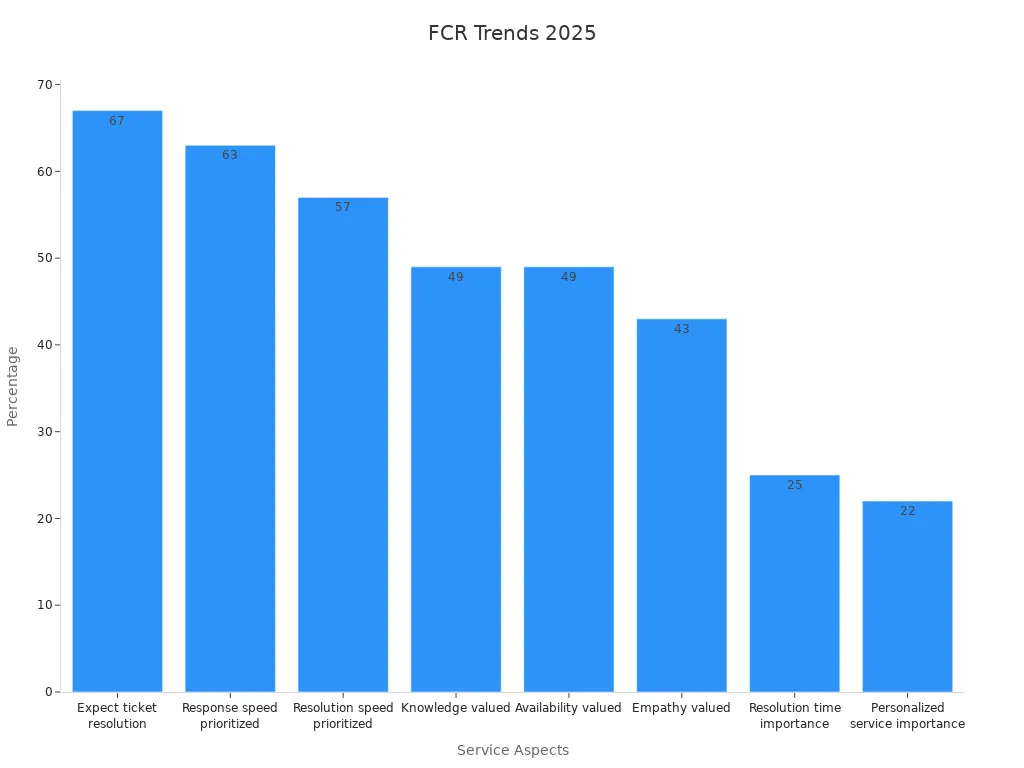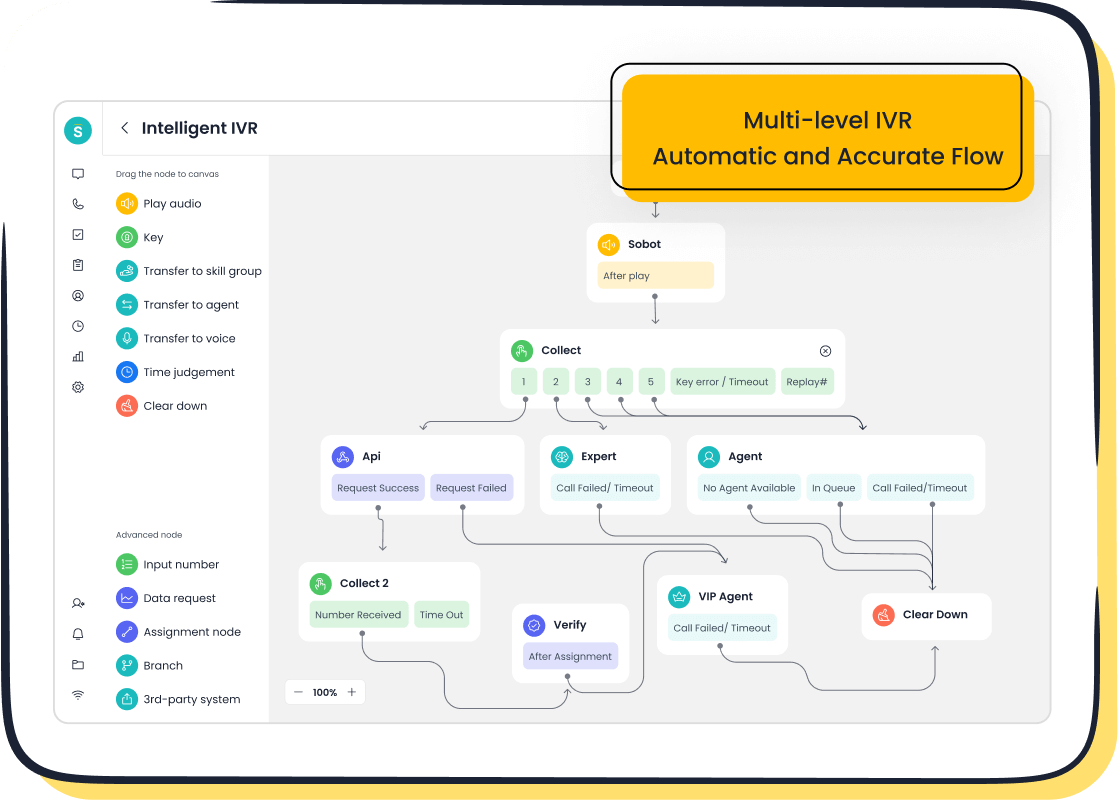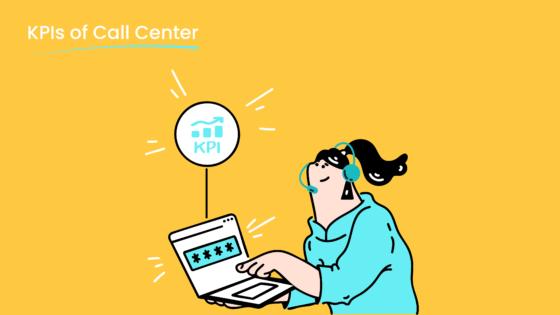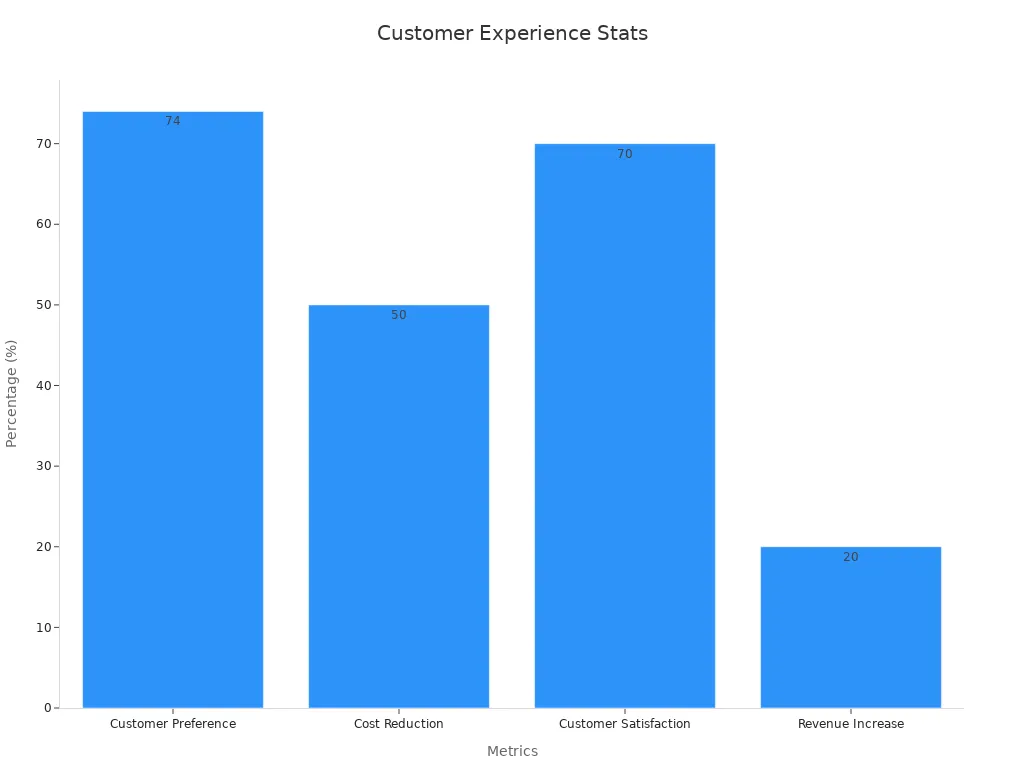Expert Tips to Improve First Contact Resolution in Modern Contact Centers

First Contact Resolution (FCR) has become a cornerstone of customer service excellence. It ensures that customer issues are resolved during the initial interaction, reducing frustration and building trust. Studies show that improving FCR can enhance customer satisfaction scores by up to 62% while boosting operational efficiency by 56%. High-volume contact centers that focus on one-touch resolutions also report lower costs and better agent retention. Tools like Sobot's Voice/Call Center simplify workflows and empower agents with AI-driven insights, enabling an impressive 85% resolution rate. To effectively understand how to measure first contact resolution, businesses can leverage Sobot's comprehensive analytics features. By investing in FCR improvement, you can transform your customer service strategy into a competitive advantage.
Understanding First Contact Resolution (FCR)

What is First Contact Resolution?
First contact resolution refers to the ability to resolve a customer’s issue during their initial interaction with your support team, regardless of the channel they use. This could be through a phone call, live chat, email, or even social media. Unlike first call resolution, which focuses solely on phone interactions, first contact resolution encompasses all communication platforms. It ensures that customers don’t need to follow up multiple times, saving them time and reducing frustration.
To measure this effectively, you can calculate the first contact resolution rate using the formula:
(Number of issues resolved on first contact ÷ Total number of issues) × 100.
For example, if your team resolves 800 out of 1,000 customer inquiries on the first attempt, your first contact resolution rate would be 80%. This metric provides a clear picture of how well your team meets customer expectations.
Why FCR is a Key Metric in Customer Service
FCR is more than just a performance indicator; it’s a cornerstone of excellent customer service. Studies show that 95% of customers are more likely to remain loyal when their issues are resolved on the first contact. Additionally, a 1% improvement in FCR can reduce operating costs by 1% and increase customer satisfaction by the same margin.
Here’s a quick look at why FCR matters:
| Statistic | Impact on Customer Service Operations |
|---|---|
| 9 out of 10 times customers are dissatisfied due to FCR not occurring. | Highlights the critical role of FCR in customer satisfaction. |
| Approximately 40% of customers defect due to FCR not occurring. | Indicates the importance of FCR for customer retention. |
| For every 1% improvement in FCR, operating costs reduce by 1%. | Demonstrates cost efficiency linked to FCR. |
| 95% of customers continue business due to achieving FCR. | Shows the direct correlation between FCR and customer loyalty. |
| Cross-selling acceptance rate increases by 20% when calls are resolved. | Suggests FCR enhances sales opportunities. |
By focusing on FCR, you not only improve customer satisfaction but also create opportunities for cross-selling and upselling, boosting your bottom line.
FCR vs. First Call Resolution: Key Differences
While first contact resolution and first call resolution sound similar, they differ in scope. First call resolution focuses exclusively on resolving issues during a phone call. In contrast, first contact resolution applies to all communication channels, including live chat, email, and social media.
For example, a customer might reach out via email and have their issue resolved in one reply. This counts as first contact resolution but not first call resolution. Research shows that customers whose issues are resolved immediately are far less likely to leave, with only 2% expressing dissatisfaction compared to 19% when issues remain unresolved.
In today’s omnichannel world, prioritizing first contact resolution ensures a seamless experience across all platforms, making it a more comprehensive and impactful metric for modern customer service operations.
Why First Contact Resolution Matters in 2025
Impact of FCR on Customer Satisfaction and Loyalty
First contact resolution plays a vital role in shaping customer satisfaction and loyalty. When you resolve issues during the first interaction, customers feel valued and respected. Studies show that unresolved issues lead to a 22% drop in satisfaction, while high FCR rates enhance brand loyalty. Younger customers, especially those aged 16-24, are four times more likely to switch brands due to poor customer service compared to older generations.
Customers increasingly prioritize speed and efficiency. For example, 67% expect ticket resolution within three hours, and 57% value resolution speed over other factors. By achieving first contact resolution, you meet these expectations and create a positive customer experience.
Tip: Focus on training agents to handle inquiries effectively during the first interaction. This approach not only improves satisfaction but also strengthens customer loyalty.

Operational Benefits of High FCR Rates
High FCR rates offer significant operational advantages. Resolving issues on the first contact reduces repeat calls by 57%, freeing up resources for complex tasks. Companies with high FCR rates are 2.4 times more likely to retain customers and 10 times more likely to receive recommendations.
| Indicator | Benefit |
|---|---|
| Customer Retention | Companies that quickly solve customer problems are 2.4 times more likely to retain customers. |
| Customer Recommendations | Businesses are 10 times more likely to receive recommendations when inquiries are resolved. |
| Repeat Call Reduction | A 15% improvement in FCR leads to a 57% decrease in repeat calls. |
| Agent Morale and Productivity | High FCR rates enhance agent morale and productivity, allowing focus on complex tasks. |
| Cost Reduction | Resolving issues on the first contact reduces overall workload and operational costs. |
When you prioritize first contact resolution, you improve customer satisfaction while reducing operational costs. Agents also benefit from higher morale, as they can focus on meaningful tasks instead of repetitive follow-ups.
The Role of FCR in Modern Contact Center Success
First contact resolution is a cornerstone of modern contact center success. It measures how efficiently your team resolves customer issues during the first interaction. High FCR rates reduce the overall volume of contacts, allowing your team to focus on delivering exceptional service.
| Metric | Description |
|---|---|
| First Contact Resolution | Measures the percentage of customer issues resolved on the first interaction without follow-up. |
| Importance | Strong indicator of contact center efficiency and customer satisfaction. |
| Benefits | Enhances customer experience and reduces overall volume of contacts. |

Modern contact centers rely on FCR to improve customer satisfaction and operational efficiency. By leveraging tools like Sobot's Voice/Call Center, you can monitor and optimize FCR metrics, ensuring your team delivers consistent and high-quality service.
How to Measure First Contact Resolution
Measuring first contact resolution (FCR) accurately is essential for understanding how well your customer service team resolves issues during the initial interaction. By tracking this metric, you can identify areas for improvement and enhance both customer satisfaction and operational efficiency. Below, we explore the standard formula, effective methods, and how Sobot's Voice/Call Center can simplify FCR measurement.
Standard Formula for Calculating FCR
To calculate FCR, you need a clear formula that provides consistent results. Two widely used formulas are:
| Formula Type | Formula |
|---|---|
| Standard FCR Formula | FCR = (Total number of cases resolved / Total number of cases) x 100 |
| Alternative FCR Formula | FCR = (Total issues resolved - Total issues reopened) / Total number of calls x 100 |
For example, if your team resolves 900 out of 1,000 cases on the first attempt, your FCR rate would be 90%. Alternatively, if 50 cases are reopened, the alternative formula would yield an FCR rate of 85%. Both methods provide valuable insights into your team's performance.
Tip: Choose a formula that aligns with your operational goals and stick to it for consistent FCR measurement.
Tools and Methods for Measuring FCR
Accurate FCR measurement requires the right tools and methodologies. Here are some best practices to ensure reliable tracking:
- Define what you’re measuring and maintain consistency to avoid confusion.
- Mark an issue as resolved only when the customer confirms it.
- Track reopen rates to identify unresolved cases.
According to SQM Group, a 1% improvement in FCR correlates with a 1% increase in customer satisfaction. This highlights the importance of precise tracking. Additionally, organizations using knowledge-centered support often achieve 15% higher FCR performance compared to those that don’t. By adopting these methods, you can improve both FCR measurement and overall customer service quality.
Leveraging Sobot's Voice/Call Center for FCR Tracking
Sobot's Voice/Call Center offers advanced features that simplify FCR measurement. Its unified workspace consolidates customer data, enabling agents to resolve issues efficiently. The platform also provides real-time monitoring and analytics, allowing you to track FCR performance with ease.
For example, the intelligent IVR system routes calls to the most qualified agent, increasing the likelihood of first contact resolution. Additionally, the AI-powered Voicebot handles repetitive queries, freeing agents to focus on complex issues. With a 99.99% system uptime, Sobot ensures uninterrupted service, making it a reliable choice for FCR tracking.
By integrating Sobot's Voice/Call Center into your operations, you can enhance FCR measurement methods, improve agent productivity, and deliver exceptional customer service.
Common Challenges in Improving FCR Rates

Lack of Agent Training and Knowledge
Your agents are the backbone of your customer service operations. Without proper training, they may struggle to resolve issues effectively during the first interaction. This directly impacts first contact resolution rates.
- Inadequate training often results in longer call durations.
- Agents may transfer calls unnecessarily due to a lack of knowledge.
- Incorrect information provided to customers can lead to dissatisfaction and repeat calls.
By investing in robust training programs, you can equip your team with the skills and knowledge needed to handle inquiries confidently. This step is crucial for improving FCR and ensuring a seamless customer experience.
Tip: Regularly update your training materials to reflect changes in products, services, or policies. This keeps your agents informed and prepared to resolve issues on the first contact.
Inefficient Processes and Workflows
Disorganized workflows can create bottlenecks that hinder FCR improvement. When processes are unclear or overly complex, your team may struggle to deliver quick resolutions.
- A healthcare organization found that patients couldn’t reach their doctors due to process inefficiencies, leading to repeat calls.
- Customer confusion about a loyalty program caused unnecessary follow-ups until the issue was addressed.
- One call center used speech analytics to retrain agents, reducing repeat calls from 40% to 30%.
Streamlining your workflows can eliminate these inefficiencies. Clear processes and well-defined roles help your team focus on resolving issues during the first interaction.
Note: Consider using tools like Sobot's Voice/Call Center to automate repetitive tasks and optimize workflows. This can significantly enhance your FCR rates.
Technology Gaps and Integration Issues
Outdated systems or poorly integrated tools can prevent your team from achieving high first contact resolution rates. Technology gaps often lead to delays, errors, and missed opportunities to resolve issues efficiently.
- Identifying technology gaps is essential for understanding what hinders FCR.
- Assessing your support system can reveal bottlenecks caused by outdated infrastructure.
- Addressing these gaps improves efficiency and boosts FCR performance.
Modern solutions, such as Sobot's Voice/Call Center, offer seamless integration with existing systems. This ensures your agents have access to the tools and data they need to resolve customer issues quickly.
Tip: Regularly evaluate your technology stack to ensure it supports your FCR improvement goals. Upgrading to advanced tools can make a significant difference in your customer service outcomes.
Misaligned Customer Expectations and Service Delivery
Misaligned customer expectations often create significant barriers to achieving high first contact resolution rates. When your service delivery does not align with what customers anticipate, frustration builds, and repeat interactions become inevitable. This mismatch can stem from unclear communication, unrealistic promises, or a lack of understanding of customer needs.
Several factors contribute to this misalignment:
- Misaligned SLA/OLA targets and performance: Service-level agreements (SLAs) may not reflect what customers expect, causing delays in resolving complaints.
- Flawed complaint prioritization and channelization logic: Ineffective processes, such as poor escalation systems, can prolong resolution times and reduce FCR rates.
For example, if your team prioritizes inquiries based on internal metrics rather than customer urgency, dissatisfaction grows. Customers expect quick resolutions, especially for urgent issues. When these expectations are unmet, they often escalate their concerns, leading to additional interactions and lower FCR rates.
To address this, you must focus on understanding your customers’ expectations. Conduct regular surveys or feedback sessions to identify gaps between what customers want and what your team delivers. Use this data to refine your processes and ensure they align with customer priorities. For instance, if customers value speed, consider implementing tools like Sobot's Voice/Call Center. Its intelligent IVR and smart call routing features can help direct inquiries to the right agents, improving resolution rates.
Clear communication also plays a vital role. Set realistic expectations during the first interaction. Inform customers about resolution timelines and next steps. This transparency builds trust and reduces the likelihood of follow-ups, boosting your FCR performance.
By aligning your service delivery with customer expectations, you can enhance satisfaction, reduce repeat contacts, and achieve higher FCR rates.
Expert Tips to Improve First Contact Resolution
Invest in Agent Training and Development
Your agents are the first point of contact for customers, making their skills and knowledge critical to achieving high first contact resolution rates. Comprehensive training equips them to handle inquiries effectively, reducing call transfers and improving customer satisfaction. Studies show that well-trained agents can boost satisfaction rates significantly while lowering repeat calls.
| Metric | Impact |
|---|---|
| Improved Customer Satisfaction | Well-trained agents handle calls more effectively, leading to higher satisfaction rates. |
| Reduced Call Transfers | Improves first-call resolution (FCR). |
Training programs should focus on product knowledge, communication skills, and problem-solving techniques. For example, agents who understand your offerings thoroughly can resolve issues faster, minimizing the need for follow-ups. Regular workshops and refresher courses keep your team updated on changes in policies or services.
Tip: Incorporate role-playing exercises into training sessions. These simulations prepare agents for real-world scenarios, boosting their confidence and ability to resolve issues during the first interaction.
Investing in agent development also reduces operational costs. Research reveals that a 1% improvement in FCR correlates with a 1% reduction in operating expenses. Additionally, 95% of customers express intent to continue business when their issues are resolved on the first contact. By prioritizing training, you create a strategy that enhances customer satisfaction and operational efficiency.
Use AI and Automation for Faster Resolutions
AI and automation technologies streamline customer service processes, enabling faster and more consistent resolutions. Virtual assistants and chatbots can handle repetitive queries, freeing agents to focus on complex issues. For instance, Capital One’s AI-powered assistant, Eno, reduced average handling times by 50% and increased customer satisfaction scores by 15%. Similarly, eBay’s AI-driven chatbots improved first-contact resolution rates by 20%, enhancing customer satisfaction by 10%.
Automation tools also provide real-time insights, helping agents make informed decisions. AI-powered systems analyze customer data to predict intent, ensuring inquiries are routed to the most qualified agent. This reduces resolution times and boosts FCR rates.
Note: Implementing AI doesn’t replace human agents but complements their efforts. Use automation to handle routine tasks while empowering your team to focus on delivering personalized service.
Sobot’s Voice/Call Center integrates AI-powered Voicebots that recognize customer intent and provide intelligent interactions. These features enhance resolution speed and accuracy, making them ideal for improving FCR. By leveraging AI and automation, you can adopt best practices that align with modern customer service expectations.
Optimize Processes with Sobot's Voice/Call Center
Streamlined processes are essential for achieving high first contact resolution rates. Disorganized workflows often lead to delays and inefficiencies, frustrating customers and increasing repeat calls. Sobot’s Voice/Call Center offers tools to optimize your operations, ensuring inquiries are resolved efficiently during the first interaction.
The platform’s intelligent IVR system routes calls to the most qualified agent, reducing unnecessary transfers. Its unified workspace consolidates customer data, enabling agents to access relevant information quickly. These features improve resolution speed and accuracy, enhancing both customer satisfaction and operational efficiency.
| Feature | Benefit |
|---|---|
| Intelligent IVR | Routes calls to the right agent, increasing resolution rates. |
| Unified Workspace | Provides agents with comprehensive customer data for faster resolutions. |
| AI-Powered Voicebot | Handles repetitive queries, freeing agents for complex tasks. |
Sobot’s Voice/Call Center also supports global telephony contacts and offers seamless integration with CRM systems. These capabilities ensure your team has the tools needed to deliver exceptional service. With a 99.99% system uptime, Sobot guarantees reliability, making it a trusted solution for optimizing FCR strategies.
Tip: Use Sobot’s real-time analytics to monitor FCR metrics. Regular tracking helps identify areas for improvement, ensuring your processes remain efficient and customer-focused.
By optimizing workflows with Sobot’s Voice/Call Center, you can implement FCR best practices that drive customer satisfaction and operational success.
Create Feedback Loops for Continuous Improvement
Feedback loops are essential for improving first contact resolution (FCR) rates. They provide a structured way to analyze performance and identify areas for growth. By creating continuous feedback mechanisms, you can ensure your team consistently delivers high-quality customer service.
Here’s how feedback loops drive improvement:
- They capture key performance metrics, such as FCR and first call resolution rates.
- Structured tools, like call center scoring forms, help evaluate agent interactions.
- Regular analysis of customer interactions uncovers actionable insights for development.
For example, you can use post-interaction surveys to gather customer feedback. These surveys reveal whether issues were resolved during the first contact. If not, they highlight areas where agents need additional training or support.
Sobot’s Voice/Call Center simplifies this process. Its real-time analytics track FCR metrics, while its unified workspace consolidates customer data. This allows you to monitor agent performance and implement targeted improvements. By leveraging these tools, you can create a feedback loop that enhances both agent efficiency and customer satisfaction.
Tip: Schedule regular team reviews to discuss feedback and share best practices. This fosters a culture of continuous learning and improvement.
Recognize and Reward High-Performing Agents
Recognizing and rewarding high-performing agents motivates your team to excel. When agents feel valued, they are more likely to stay engaged and committed to delivering exceptional customer service.
Start by identifying agents who consistently achieve high FCR and first call resolution rates. Use metrics like resolution speed, customer satisfaction scores, and feedback from customers to evaluate performance. For instance, an agent who resolves 95% of issues on the first contact demonstrates exceptional skill and dedication.
Here are some ways to reward top performers:
- Offer monetary incentives, such as bonuses or gift cards.
- Provide public recognition during team meetings or through internal newsletters.
- Create opportunities for career growth, like advanced training or leadership roles.
Sobot’s Voice/Call Center can help you track agent performance with its real-time monitoring and analytics features. By using these insights, you can identify high achievers and tailor rewards to their contributions. This not only boosts morale but also encourages other agents to improve their performance.
Note: Recognition doesn’t always have to be monetary. A simple “thank you” or a personalized note can go a long way in making agents feel appreciated.
Standardize Scripts for Common Customer Issues
Standardizing scripts for common customer issues ensures consistency and efficiency in your customer service operations. Scripts provide agents with a clear framework for handling inquiries, reducing the likelihood of errors and improving FCR rates.
To create effective scripts, start by analyzing frequently asked questions and common problems. For example, if customers often call about billing issues, develop a script that guides agents through the resolution process step by step. Include key phrases that reassure customers and demonstrate empathy.
Here’s what a good script should include:
- A friendly greeting to set a positive tone.
- Clear instructions for resolving the issue.
- Closing statements that confirm the resolution and invite further questions.
Sobot’s Voice/Call Center supports script standardization with its intelligent IVR and AI-powered Voicebot features. These tools guide agents through interactions, ensuring they follow best practices. Additionally, the platform’s unified workspace provides access to customer data, enabling personalized service even within a standardized framework.
Tip: Regularly review and update your scripts to reflect changes in products, services, or customer expectations. This keeps your team prepared to handle any situation effectively.
Monitor and Analyze FCR Metrics Regularly
Monitoring and analyzing FCR metrics regularly is essential for improving your contact center's performance. By tracking these metrics, you can identify patterns, uncover inefficiencies, and make data-driven decisions to enhance customer satisfaction. Regular analysis ensures that your team stays aligned with your goals and delivers consistent results.
To start, focus on key metrics that reveal the impact of your efforts. These include:
- First contact resolution rates, which measure how efficiently your team resolves customer inquiries during the first interaction.
- Customer satisfaction scores, which reflect how well your service meets customer needs.
- Customer effort scores, which show how easy it is for customers to resolve their issues.
- Repeat call rates, which highlight unresolved issues and areas needing improvement.
Tracking these metrics provides valuable insights into your team's performance. For example, a high repeat call rate may indicate gaps in training or unclear processes. By addressing these issues, you can improve FCR and reduce customer frustration.
Soliciting customer feedback is another effective way to monitor FCR. Feedback helps you uncover recurring problems and identify opportunities for improvement. For instance, if customers frequently mention long wait times, you can adjust staffing levels or optimize workflows to address the issue. Regular feedback also shows customers that you value their input, which strengthens their trust in your brand.
Using advanced tools like Sobot's Voice/Call Center simplifies the process of monitoring and analyzing FCR metrics. Its real-time analytics provide a clear view of your team's performance, while its unified workspace consolidates customer data for easy access. Features like intelligent IVR and AI-powered Voicebots help streamline operations, ensuring your team resolves issues efficiently during the first interaction.
Tip: Schedule weekly or monthly reviews of your FCR metrics. This practice helps you stay proactive and ensures that your team consistently meets customer expectations.
By monitoring and analyzing FCR metrics regularly, you can create a culture of continuous improvement. This approach not only enhances customer satisfaction but also boosts your team's efficiency and morale.
First Contact Resolution (FCR) is a vital metric in modern customer service. It directly impacts customer satisfaction, loyalty, and operational efficiency. Research shows that every 1% improvement in FCR increases customer satisfaction by 1% and transactional Net Promoter Score® by 1.4 points. Sustained improvements in FCR require repeatable behaviors and seamless operational design, not temporary fixes.
The expert tips shared in this blog—such as investing in agent training, leveraging AI, and optimizing workflows—offer practical strategies to enhance FCR. Tools like Sobot's Voice/Call Center simplify these efforts with features like intelligent IVR, AI-powered Voicebots, and real-time analytics. These solutions not only improve resolution rates but also elevate the overall customer experience.

By adopting these strategies and leveraging Sobot's innovative solutions, you can transform your customer service operations and achieve exceptional results.
FAQ
What is the ideal first contact resolution (FCR) rate for a contact center?
An ideal FCR rate ranges between 70% and 90%. Achieving this range indicates that your team resolves most issues during the first interaction. A higher rate improves customer satisfaction and reduces operational costs, making it a key performance metric for modern contact centers.
How does FCR impact customer loyalty?
FCR directly influences customer loyalty. Resolving issues on the first contact builds trust and satisfaction. Studies show that customers are 95% more likely to stay loyal when their concerns are addressed promptly. This metric ensures a positive experience, encouraging repeat business.
Can technology improve FCR rates?
Yes, technology plays a crucial role in improving FCR. Tools like Sobot's Voice/Call Center streamline workflows, provide real-time data, and automate repetitive tasks. These features help agents resolve customer issues faster, enhancing both efficiency and satisfaction.
How do you measure FCR across multiple channels?
To measure FCR across channels, track the percentage of issues resolved during the first interaction on each platform (e.g., phone, email, chat). Use tools like Sobot's analytics to consolidate data and monitor performance. Consistent tracking ensures accurate insights into your customer service effectiveness.
Why do customers value first contact resolution?
Customers value FCR because it saves time and reduces frustration. Resolving issues during the first interaction shows that you prioritize their needs. This approach enhances their experience, making them more likely to recommend your services and remain loyal to your brand.
See Also
A Complete Guide to Omnichannel Contact Center Implementation
Essential Practices for Effective Call Center Quality Management
2024 Review of Leading Contact Center Solutions Available
